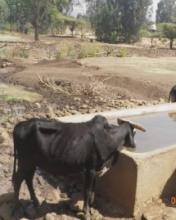MUS by design
This is the synthesis report of the e-discussion on multiple-use water services which was held from 28 April - 24 May 2014.
The e-discussion aimed to:
- Improve understanding among water practitioners of the MUS approach and explore how it links with issues of interest to RWSN: household investments in self-supply for multiple uses, equity considerations in multiple uses and the relation between multiple uses of water and sustainable services.
- Bring together a network of practitioners from different disciplines to share learning from approaches that have worked or have not.
- Unlock practical experience and capture in a synthesis. The synthesis will outline current knowledge gaps, policy implications, and highlight issues for the four RWSN thematic groups to take forward.
- Identify immediate and longer term actions for the MUS group and RWSN members.
Presentation by Katie Spooner of CAFOD on moving towards a MUS approach and building resilience and sustainability.
Presentation by Tidiane Diallo, Regional Technical Adviser of WaterAid West Africa on practices and experiences in the West Africa region.
This video is called Solar Multiple Use Water System and has been produced with the support of Renewable World. Renewable World works with local partners (IDE and SAPPROS Nepal) to build their capacities to deliver renewable energy services to remote and marginal communities.
Presentation by Barbara van Koppen on issues around MUS.
Presentation by Jeroen Vos of Wageningen University and Research centre on whether multiple-use water services require a specific design approach.
The Community Managed Project approach (CMP) gives facility users the mandate to plan and manage the implementation of facilities. Water committees manage the facility construction from beginning to end, so there is no handover of the facilities after completion, unlike projects managed by local authorities or NGOs.
The design of these facilities is mainly focused towards domestic water supply, but when the water source is sufficient (usually with springs and not with hand dug wells), cattle watering facilities are common additional components in the design. As the CMP approach builds capacity and successfully engages the private sectors and user communities from the onset, it offers opportunities for end users to pinpoint their needs to be incorporated in the design. Hence, the CMP approach can be used to introduce and promote multiple use water services from project initiation through planning and implementation to the operation and maintenance phase. This has potential, albeit practice is limited to date, enabling users to maximize their benefits from the proposed WASH facilities.
Read this case study to learn more from the current practices, technical constraints and opportunities for scaling up.
The case study is part of the MUStRAIN case study series in which the uptake of Multiple Use Services (MUS) in different contexts within Ethiopia is being documented.
Powerpoint presentation by Jonathan Chisaka, International Water Management Institute, given at the World Water Forum in Turkey, 2009.
A power point presentation giving an overview of fieldwork in the Adidaero Watershed in Enderta Wereda, Tigray Region.
A fieldwork report on community level assessment on the understanding of the existing multiple-water use system, Northern Ethiopia.

